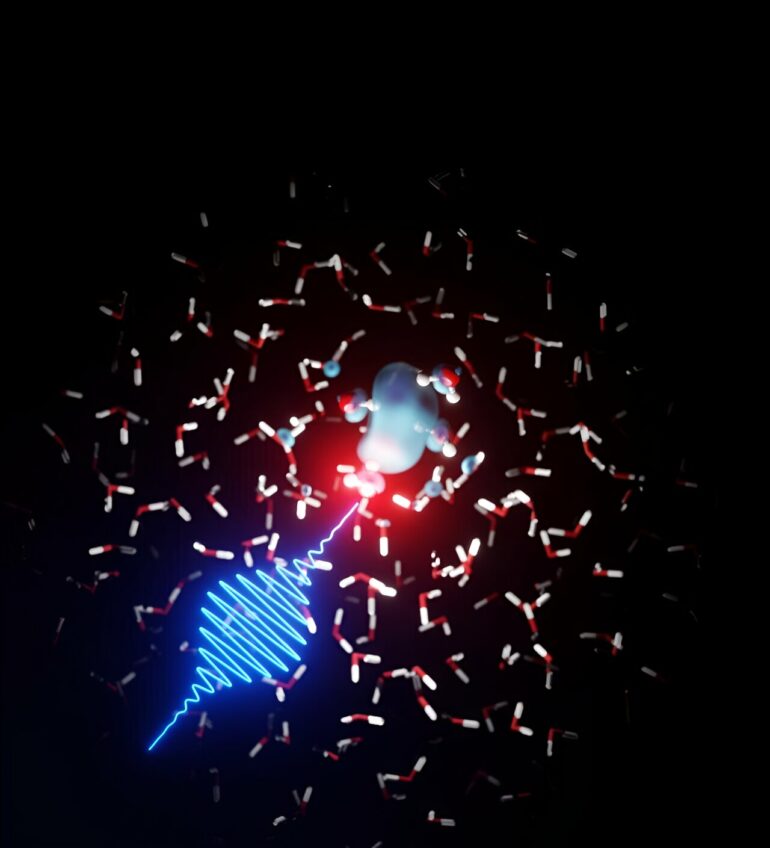What happens when radiation hits water? This is a question that has an impact every time you get an X-ray at the doctor’s office, given you are mostly made of water. A team of theoretical physicists at DESY has worked on data taken by colleagues from Argonne National Laboratory in the US at the LCLS X-ray laser in California to get a better answer to this question.
What they found may settle a controversy in physics about the presence of free electrons in water and how they behave at very short time scales: the electrons, unbound to atoms, become sequestered in bubbles in cage-like structures between individual water molecules. These findings are reported in the Journal of the American Chemical Society.
Free electrons are electrons that are not bound to atoms. In water that comes into contact with radiation, free electrons emerge from the water molecules as they ionize due to the radiation. How the electrons flow between the water molecules in this situation has been a topic of discussion for a longer time.
In their work at LCLS at the SLAC National Accelerator Laboratory, the experimental team, led by Argonne scientist Linda Young, saw odd signatures associated with the water molecules excited by lasers and imaged by the X-ray laser. They found structures among the molecules using X-ray absorption spectroscopy. In order to gain a better understanding of what these results meant, the experiment team turned to theoretical physicists in Hamburg.
A team led by DESY scientist Ludger Inhester of the Center for Free-Electron Laser Science examined the data and began making models from the data in coordination with the experimental team. Together their findings show that the free electrons in the water form bubble structures that are then caged in by water molecules, similar to how chemicals are solvated in water at the molecular level. In particular, the DESY team managed to show the process behind this solvation of electrons in the water and its parameters.
“It turns out that the dissolution process and thus the formation of the cage structures is remarkably sensitive to temperature changes in the water,” says Arturo Sopena, the first author of the study.
The new insights into the solvation process show that the electron, which at first can be found over a wide area among the water molecules, docks onto specific hydrogen bonding patterns that occur in the molecular liquid water and then “burrows” deeper into a very narrow area within the water structure.
This “burrowing” and the associated reorientation of the neighboring water molecules takes place remarkably quickly and is completed within 100 femtoseconds, where a femtosecond is a quadrillionth of a second. The bubble, which is about 50 billionths of a meter wide, disassociates within several picoseconds, or a trillionth of a second.
“How does water react when exposed to radiation? This is a vital question,” says Inhester. “These are the first chemical reaction steps that are driven by the radiation that also determine the following radiation chemistry, which applies as well to biological material.”
The new work was also carried out as part of the Cluster of Excellence CUI: Advanced Imaging of Matter at Universität Hamburg. The new findings provide further insight into the behavior of radiation damage caused by ionizing radiation in water. Such water-relevant research is to be further intensified at the emerging Center for Molecular Water Science, which is being established in international cooperation on the DESY campus.
More information:
Arturo Sopena Moros et al, Tracking Cavity Formation in Electron Solvation: Insights from X-ray Spectroscopy and Theory, Journal of the American Chemical Society (2024). DOI: 10.1021/jacs.3c11857
Provided by
Deutsches Elektronen-Synchrotron
Citation:
Scientists uncover a new model for the effects of radiation in water systems (2024, February 8)



